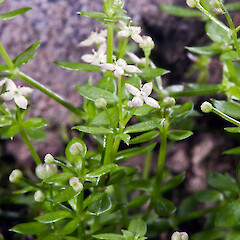Galium trilobum
Common name
native bedstraw
Synonyms
Galium tenuicaule A.Cunn . nom. illegit. non Krocker (1823)
Family
Rubiaceae
Flora category
Vascular – Native
Endemic taxon
Yes
Endemic genus
No
Endemic family
No
Structural class
Herbs - Dicotyledons other than Composites
NVS code
The National Vegetation Survey (NVS) Databank is a physical archive and electronic databank containing records of over 94,000 vegetation survey plots - including data from over 19,000 permanent plots. NVS maintains a standard set of species code abbreviations that correspond to standard scientific plant names from the Ngä Tipu o Aotearoa - New Zealand Plants database.
GALTRI
Chromosome number
2n = 44
Current conservation status
The conservation status of all known New Zealand vascular plant taxa at the rank of species and below were reassessed in 2017 using the New Zealand Threat Classification System (NZTCS) – more information about this can be found on the NZTCS website. This report includes a statistical summary and brief notes on changes since 2012 and replaces all previous NZTCS lists for vascular plants.
Please note, threat classifications are often suggested by authors when publications fall between NZTCS assessment periods – an interim threat classification status has not been assessed by the NZTCS panel.
- Conservation status of New Zealand indigenous vascular plants, 2017 . 2018. Peter J. de Lange, Jeremy R. Rolfe, John W. Barkla, Shannel P. Courtney, Paul D. Champion, Leon R. Perrie, Sarah M. Beadel, Kerry A. Ford, Ilse Breitwieser, Ines Schönberger, Rowan Hindmarsh-Walls, Peter B. Heenan and Kate Ladley. Department of Conservation. Source: NZTCS and licensed by DOC for reuse under the Creative Commons Attribution 4.0 International licence.
2017 | Not Threatened
Previous conservation statuses
2012 | Not Threatened
2009 | Not Threatened
2004 | Not Threatened
Distribution
Endemic to New Zealand. North and South Island.
Habitat
Lowland to upland. In shady, damp and wet places, such as forest margins, scrub, stream and lake sides, moist pastures and tussockland, shrubland, rushland in seepage and near swamps.
Wetland plant indicator status rating
Information derived from the revised national wetland plant list prepared to assist councils in delineating and monitoring wetlands (Clarkson et al., 2021 Manaaki Whenua – Landcare Research Contract Report LC3975 for Hawke’s Bay Regional Council). The national plant list categorises plants by the extent to which they are found in wetlands and not ‘drylands’. The indicator status ratings are OBL (obligate wetland), FACW (facultative wetland), FAC (facultative), FACU (facultative upland), and UPL (obligate upland). If you have suggestions for the Wetland Indicator Status Rating, please contact: [Enable JavaScript to view protected content]
FACU: Facultative Upland
Occasionally is a hydrophyte but usually occurs in uplands (non-wetlands).
Detailed description
Perennial herb with straggling, slender stems, 10-70cm long. Leaf stems 0.5-3mm long. Leaves 2-10mm long, 0.8-3mm wide, narrower elliptic or spoon-shaped, in whorls of 4. Flower stalks up to 20mm long. Flowers white, starry, 2-3mm diameter, 3-4 clumped in lead axils. Fruit small, round, dark brown.
Similar taxa
Galium propinquum, G. palustre, G. perpusillum. G. trilobum has narrower, longer leaves and larger flowers on longer flower stems than G. propinquum. The introduced G. palustre has 5-30 flowers per head. G. perpusillum has narrower leaves, shorter stems and single flowers.
Flowering
September to March
Flower colours
White
Fruiting
November to May
Life cycle
Mericarps are dispersed by attachment and possibly also wind (Thorsen et al., 2009).
Propagation technique
Easily grown from cuttings and fresh seed but appears to be hard to maintain in cultivation.
Threats
Not Threatened but exact distribution unclear as it is frequently confused with the introduced Galium palustre and G. debilis. Herbarium evidence suggests it has declined from a large part of its northern North Island range but is still common in large parts of southern North Island, and along the eastern side of South Island. There is some evidence that two forms of G. trilobum exist, and this complicates conservation assessments. The one described here, matches the widespread form, and is commonly found in grey scrub communities and wetlands in the drier eastern part of the country. The other is now scarce, seemingly preferring raupo reedlands, and is a larger plant, with longer primarily sublinear leaves.
Etymology
galium: From the Greek galo ‘milk’, the leaves of Galium verum being used in the past to curdle milk
trilobum: Three-lobed
Where To Buy
Not commercially available
Attribution
Fact sheet prepared by P.J. de Lange for NZPCN (1 June 2013)
References and further reading
Thorsen, M. J.; Dickinson, K. J. M.; Seddon, P. J. 2009. Seed dispersal systems in the New Zealand flora. Perspectives in Plant Ecology, Evolution and Systematics 11: 285-309
NZPCN Fact Sheet citation
Please cite as: de Lange, P.J. (Year at time of access): Galium trilobum Fact Sheet (content continuously updated). New Zealand Plant Conservation Network. https://www.nzpcn.org.nz/flora/species/galium-trilobum/ (Date website was queried)



